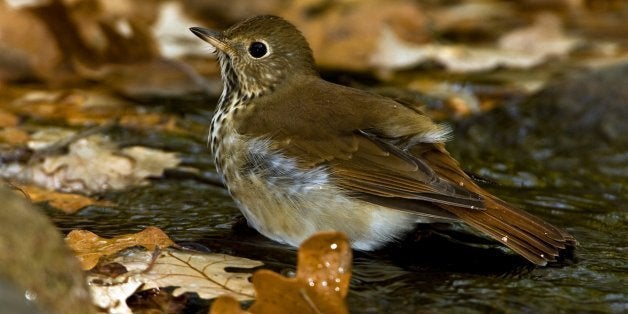
If you, like millions of other nature lovers, enjoy songbirds every spring, it may be because their tunes are more like human music than you realize.
At least, that's the case for one songbird: the hermit thrush. With populations ranging from Vermont, where it's the official state bird, all the way to Alaska, this pint-sized songbird has been noted by naturalists since the 19th century for its flute-like calls. Walt Whitman wrote of its "victorious song," and the Netflix series "House of Cards" even name-checked the bird last season. But is the hermit thrush really musically gifted, or are people just listening for the tunes they want to hear?
Recently, a team of researchers, using computers that early bird watchers never dreamed of, analyzed 71 thrush recordings made all around North America during the past half century.
In findings published Monday in the journal Proceedings of the National Academy of Sciences, they conclude: The same mathematical principles that dictate the scales used in nearly all human music can also be found in the notes the hermit thrush chooses to sing.
"The current study provides the first conclusive evidence for a musical scale in birdsong, at least in one species," said Ofer Tchernichovski, a songbird researcher at Hunter College who was not involved in the study. "Overall, I suspect that birdsong is similar to human music in more than one way, and pitch intervals is only one method for studying it."
The researchers argue that although the hermit thrush can produce a variety of tones, it often chooses to sing only a certain set of notes. The relationship between these notes follows what musicians call the harmonic series -- a string of notes that starts with a base frequency, followed by a note with double that frequency, then a note with triple the frequency, and so on. Each major and minor scale -- and, by extension, nearly all music from Mozart to Metallica -- is derived from this series.
The hermit thrush sometimes uses "scales" that, despite being drawn from the harmonic series, don't exactly resemble human music. But occasionally, the bird's song follows a recognizable pattern.
For example, listen to this recording of a hermit thrush:
First, you hear the raw recording taken in the field. Then you hear the notes re-ordered from lowest to highest pitch. Finally, you hear those pitches reproduced electronically.
Mathematically, those four notes are roughly related to each other in the same way that E, F, G and A are in the C major scale. But again, the researchers point out, not every recording sounds as sweet as this.
"I think it's important to avoid projecting things we are familiar with onto animal songs," said Emily Doolittle, a co-author of the study and assistant professor of music composition at Cornish College of the Arts in Seattle.
"But I think we're missing out on an important way to understand these songs if we fail to pay attention to pitch relationships or other aspects that musicians may think about more often than scientists," Doolittle added.
Here are a few more particularly melodic calls:
Like most songbirds, the male hermit thrush sings to mark its territory and attack mates. Perhaps the pitch-perfect singers get the girls, providing an evolutionary incentive for the thrush to hit the right notes, the researchers suggest.
However, not all songbirds are as melodic. Two other American songbirds, the white-throated sparrow and the nightingale wren, don't choose pitches like humans do, other studies have found.
Still, the parallels between birdsong and human music suggest we're not the only species that appreciates harmony. Newly hatched baby chicks will waddle toward speakers playing pleasant-sounding music, and even mosquitoes buzz at harmonious pitches right before they're about to mate.
"The fact that at least one species uses the principles found in human music suggests that there may be biological reasons for the basis of music," said Bruno Gingras, a postdoctoral fellow at the University of Vienna and co-author of the study.
